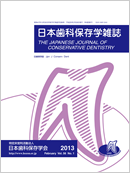Volume 49, Issue 4
Displaying 1-9 of 9 articles from this issue
- |<
- <
- 1
- >
- >|
Review
-
Article type: Review
2006 Volume 49 Issue 4 Pages 497-502
Published: August 31, 2006
Released on J-STAGE: March 31, 2018
Download PDF (1192K)
Original Articles
-
Article type: Original Articles
2006 Volume 49 Issue 4 Pages 503-509
Published: August 31, 2006
Released on J-STAGE: March 31, 2018
Download PDF (1236K) -
Article type: Original Articles
2006 Volume 49 Issue 4 Pages 510-515
Published: August 31, 2006
Released on J-STAGE: March 31, 2018
Download PDF (811K) -
Article type: Original Articles
2006 Volume 49 Issue 4 Pages 516-522
Published: August 31, 2006
Released on J-STAGE: March 31, 2018
Download PDF (1380K) -
Article type: Original Articles
2006 Volume 49 Issue 4 Pages 523-529
Published: August 31, 2006
Released on J-STAGE: March 31, 2018
Download PDF (976K) -
Article type: Original Articles
2006 Volume 49 Issue 4 Pages 530-536
Published: August 31, 2006
Released on J-STAGE: March 31, 2018
Download PDF (753K) -
Article type: Original Articles
2006 Volume 49 Issue 4 Pages 537-544
Published: August 31, 2006
Released on J-STAGE: March 31, 2018
Download PDF (817K) -
Article type: Original Articles
2006 Volume 49 Issue 4 Pages 545-551
Published: August 31, 2006
Released on J-STAGE: March 31, 2018
Download PDF (1290K) -
Article type: Original Articles
2006 Volume 49 Issue 4 Pages 552-557
Published: August 31, 2006
Released on J-STAGE: March 31, 2018
Download PDF (639K)
- |<
- <
- 1
- >
- >|
